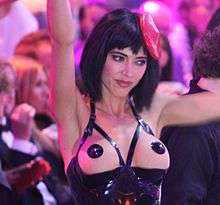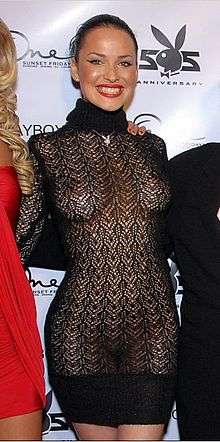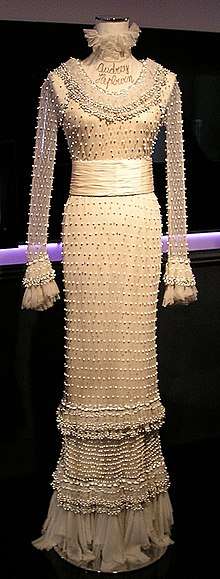Fetish fashion
Fetish fashion is any style or appearance in the form of a type of clothing or accessory, created to be extreme or provocative in a fetishistic manner. These styles are not usually worn by the majority of people on any regular basis. They are usually made of materials such as leather, latex or synthetic rubber or plastic, nylon, PVC, spandex, fishnet, and stainless steel. Some fetish fashion items include: stiletto heel shoes and boots (most notably the ballet boot), hobble skirts, corsets, collars, full-body latex catsuits, stockings, miniskirt, crotchless underwear, diapers, garters, locks, rings, zippers, eyewear, handcuffs, and stylized costumes based on more traditional outfits, such as wedding dresses that are almost completely see-through lace. Fetish fashions are sometimes confused with costuming, because both are usually understood to be clothing that is not worn as the usual wardrobe of people, and are instead worn to create a particular reaction.


Fetish fashions are usually considered to be separate from those clothing items used in cosplay, whereby these exotic fashions are specifically used as costuming to effect a certain situation rather than to be merely worn; such as the creation of a character for picture play. However, sometimes the two areas do overlap. For example, in Japan, many themed restaurants have waitresses who wear costumes such as a suit made of latex or a stylized French maid outfit.
Fetish fashion clothing is often modelled by specialist fetish models.
Some type of garments that women wear to routinely improve their appearance are thought of as erotic and qualify as fetish wear: corsets and high heels. Most fetish wear is not practical enough for routine daily wear. An example of a fetish costume worn by women is the dominatrix costume. This typically consists of dark or black garments including a corset or bustier, stockings and high-heeled footwear such as thigh-high boots to enhance the dominating appearance. An accessory such as a whip or a riding crop is often carried.
History
Fetish fashion has no specific origin point because certain fashions that were appreciated specifically for themselves or worn as part of a specific subculture have been noted since the earliest days of clothing. Some scholars, like Michael Hayworth, argue that the use of corsetry and hobble skirts back in the late 19th century was the first mainstream note of fetish fashions, because the majority of society did not have access to these articles.[1] These items were specifically appreciated for themselves (i.e. the person liked the woman wearing the corset rather than just the woman by herself).
In 1914 a few weeks before the start of World War One, L. Richard and his wife Nativa founded their lingerie firm, Yva Richard, in Paris.[2] Their custom made unique creations became increasingly daring and avant-garde, and by the late 1920s, they had highly successful international mail-order business. Richard took most of the photographs for their catalogue, and Nativa would sometimes model. One of their most iconic designs was a studded steel cone bra and chastity belt with a plumed headdress.[3] Their success encouraged the tailor Léon Vidal, who owned a chain of erotic bookshops to open a luxurious lingerie boutique called Diana Slip.[4]
A leather subculture appeared amongst the underground gay community of London, England after World War II with gay men wearing items of leather clothing. This leather subculture later became more mainstream in the British 1960s due to the influence of rock musicians such as The Rolling Stones and The Who, and television performers such as Diana Rigg and Honor Blackman in The Avengers, who wore full body leather catsuits and full limb-covering leather and latex gloves and boots.
Many fashion designers incorporate elements of the fetish subculture into their creations or directly create products based on elements that are not accepted by the mainstream. Malcolm McLaren and Vivienne Westwood created several restrictive BDSM-inspired clothing items of punk fashion for the 1970s punk subculture; in particular bondage trousers, which connect the wearer's legs with straps. The more recent fetish clothing makers House of Harlot and Torture Garden Clothing, Breathless of London, Vex Latex Clothing and Madame S of California focus on using latex and leather as the base material for their creations, rather than as an accessory.
Publications
Fetish fashions became popularized in the United States during the 1950s through books and magazines such as Bizarre and many other underground publications. Skin Two is a contemporary fetish magazine covering many aspects of the worldwide fetish subculture. The name is a reference to fetish clothing as a second skin.
Mainstream

Fetish fashion has had an influence on mainstream fashion, both on and off the runway. Many well-known designers have used fetish wear as an inspiration, borrowing details and incorporating materials such as latex, PVC, lace, vinyl and patent leather. Such designers include Thierry Mugler, Jonathan Saunders, Alexander McQueen, Christian Dior, Chanel and Nicholas Kirkwood. The Alexander McQueen Autumn/Winter 2016 ready-to-wear collection was influenced by fetish fashion, and the inspiration of materials and pieces such as harnesses and corsets can be seen on most of the looks.[6]
Other brands have been created specifically for the fetish clothing luxury market. Zana Bayne, a post-fetish leather brand based in New York City was founded by Zana Bayne in 2010. Their work has been worn by celebrities such as Beyoncé and Lady Gaga. Zana Bayne have also collaborated with other brands such as Marc Jacobs and Comme des Garçons. Todd Pendu began working with Zana Bayne when he was at Comme des Garçons, before becoming a full-time creative partner at Zana Bayne in 2012.[7] Atsuko Kudo is another brand explicitly influenced by fetish fashion, who design and manufacture ladies wear made entirely in latex rubber.
Street fashion has also been influenced by fetish fashion. By late 2016 and through 2017 a number of fetish fashion elements had appeared in ready-to-wear and street wear around the world. This includes items such as chokers, fishnets, corsets, thigh-high boots; details such as straps, buckles, pierced ring hardware and chains; and materials like patent leather and vinyl.[8]
See also
- Charles Guyette
- Clothing fetish
- Eric Stanton
- Fetish magazine
- Gene Bilbrew
- Going commando
- Gothic fashion
- Industrial fashion
- Irving Klaw
- John Willie
- Kink (sexuality)
- Sexual fetishism
Dance Culture
Clothing
- Edible underwear
- Latex and PVC fetishism
- PVC clothing
- Spandex fetishism
- Uniform fetishism
References
- Hayworth, Michael (1994). "Fashion, Clothing, and Sex". In Bullough, Vern L.; Bullough, Bonnie (eds.). Human Sexuality: An Encyclopedia. New York and London: Garland Publishing Inc. pp. 203–4.
- City of Pleasure: Paris Between the Wars. Korero Press. 2019. p. 65. ISBN 9781912740055.
- City of Pleasure: Paris Between the Wars. Korero Press. 2019. p. 68. ISBN 9781912740055.
- City of Pleasure: Paris Between the Wars. Korero Press. 2019. p. 82. ISBN 9781912740055.
- Lauren Johnston (18 December 2008). "Hugh Hefner gal pal Dasha Astafieva bares all on Playboy red carpet". NY Daily News.
- Mower, Sarah. "Alexander McQueen Fall 2016 Ready-to-Wear Fashion Show". Vogue. Retrieved 2017-04-19.
- "Bio". ZANA BAYNE New York. Retrieved 2017-04-19.
- "Savannah College of Art and Design". 0-www.wgsn.com.library.scad.edu. Retrieved 2017-04-19.


